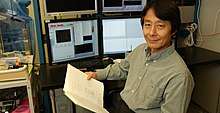Okihide Hikosaka
Okihide Hikosaka is a neuroscience research professor who specializes in the mechanisms of motivation, learning, skill, decision-making, attention, and oculomotor control. His research into neuronal mechanisms of voluntary behavior and basal ganglia function created breakthroughs in the understanding of the neurochemistry behind information-seeking behavior[1] and the efficacy of grouping motor sequence learning actions[2] (otherwise known as “chunking”) in order to remember more than individual actions.
Okihide Hikosaka | |
|---|---|
 | |
| Alma mater | University of Tokyo, Laboratory of Sensorimotor Research, NEI |
| Scientific career | |
| Fields | the mechanisms of motivation, learning, skill, decision-making, attention, and oculomotor control. |
| Institutions |
|
Hikosaka’s researched proved that the brain is chemically wired to be rewarded with dopamine for learning information about the future.
“This result supports the notion that midbrain dopamine neurons are coding for both primitive and cognitive rewards. So why do dopamine neurons treat information as a reward? It’s easy to see how treating information this way might be a useful evolutionary adaptation. For many animals, each day consists of numerous decisions that pertain to eating, reproducing and socializing. Obviously, having access to more relevant information – such as knowing where the food is located - allows animals to make better decisions. Furthermore, having access to such information might give us better control over our environment, thus increasing our chances of survival.”[3]
Hikosaka's research impacts the understanding of drug abuse, Parkinson’s and many other aspects of behavior and brain function and dysfunction.
Awards
- Gruber Foundation Neuroscience Prize, 2018[4]
- Golden Brain Award from Minerva Foundation, 2015[5]
- Tokizane Toshihiko Memorial Award, 1999[6]
- Tsukahara Memorial Award, 1989[7]
References
- Bromberg-Martin, Ethan S.; Hikosaka, Okihide (2009-07-15). "Midbrain Dopamine Neurons Signal Preference for Advance Information about Upcoming Rewards". Neuron. 63 (1): 119–126. doi:10.1016/j.neuron.2009.06.009. ISSN 0896-6273. PMC 2723053. PMID 19607797.
- Sakai, Katsuyuki; Kitaguchi, Katsuya; Hikosaka, Okihide (2003-09-01). "Chunking during human visuomotor sequence learning". Experimental Brain Research. 152 (2): 229–242. doi:10.1007/s00221-003-1548-8. ISSN 0014-4819. PMID 12879170.
- Lane, Chadrick. "The Chemistry of Information Addiction". Scientific American. Retrieved 2018-10-19.
- "Gruber Foundation Prizes in genetics, neuroscience, and cosmology announced". YaleNews. 2018-05-10. Retrieved 2018-10-19.
- "2015". Minerva Foundation. Retrieved 2018-10-19.
- "Three NIH Scientists Elected to American Academy of Arts and Sciences". National Institutes of Health (NIH). 2015-08-01. Retrieved 2018-10-19.
- "Three NIH Scientists Elected to American Academy of Arts and Sciences". National Institutes of Health (NIH). 2015-08-01. Retrieved 2018-10-19.